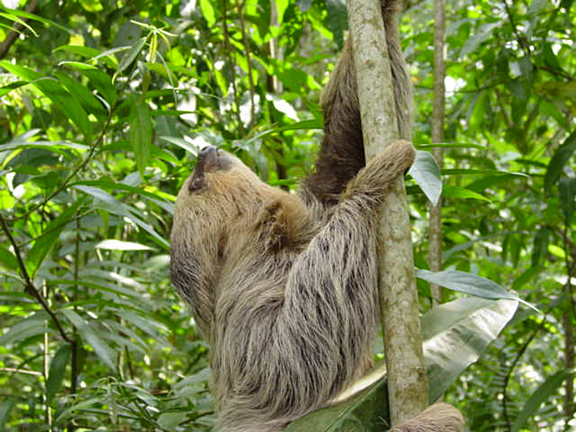 http://amazon_server.si.edu/index.html;
courtesy of Smithsonian Institute
http://amazon_server.si.edu/index.html;
courtesy of Smithsonian Institute
Introduction
Fauna are the animal life of a region or geological period
(Oxford). Animals serve an integral role in the ecosystem of the rainforest.
They interact with all parts of the ecosystem, such as flora (trees, flowers,
etc), soil, air, and water systems (amazon river, tributaries, etc). To
perserve fauna, their health has to be presereved.
Doran and Safley (1997) defined soil health as being
"the continued capacity of soil to function as a vital living system...
to sustain biological productivity, promote the quality of air and water
environments, and maintain plant, animal and human health." (Doran). This
can be applied to fauna; they are healthy if they are able to exist as
a 'vital living system' and 'sustain biological productivity.' This can
also be generalized to the entire ecosystem.
Costanza et al (1992) proposed an "ecosystem health paradigm."
Costanza discusses a combined effort of ecologists and economists to try
to create a "unifying concept of environmental management that would meet
the needs felt with regulatory agencies to adopt a broader set of management
goals than used at thte time." (Costanza). Costanza found that an ecological
system is healthy if it is "stable and sustainable."
This is very difficult to measure directly; in fact it
is nearly impossible. Therefore, a proxy must be employed. The proxy used
by ecologists is bioindicators: "... a complex concept such as ecosystem
health cannot be measured as such, but that it can be approached through
a series of indicators, each of which will measure a certain aspect..."
(van Straalen). Thus, fauna can be very important to monitoring reliably
the state of certain aspects of Amazon Rainforest health.
There are still many important questions to be resolved.
For instance, what is the relationship between species and ecosystem health?
Since one cannot investigate all species, which are the most important,
the key species? Ecological theorists have proposed answers to the former
question. Lawton (1994) tried to explain an interesting facet of the relationship
between biodiversity and ecological ability to function properly. If all
species are present and relationships unaffected, then one can be sure
that ecological functions are constant. However, the presence of all functions
does not require the presence of all species. He proposed 3 models to explain
this relationship:
a) Redundant species hypothesis - With a decrease of
biodiversity, ecosystem functions are unaffected until the point where
only a few key species remain. If one of these species is lost, the system
collapses.
b) Rivet hypothesis - With a decrease of biodiversity,
ecosystem function will decrease proportionally. This represents a direct
correlation between the two.
c) Idiosyncratic hypothesis - There is no relationship
between biodiversity and ecosystem functions.
There is some evidence for the redundant species hypothesis.
For example, Nordgren et al (1983) studied the effects of heavy metal contamination
on soil respiration. Species of fungi were killed in a gradient surrounding
the source of the metals. However, respiration was only affected with an
high level of metal (and therefore a high loss of species) near the source
(Nordgren).
In fact, there is a "general feeling...that functional
redundancy indeed plays a role..." (van Straalen). Nevertheless, despite
great efforts arising from the Rio convention, there is very little empirical
evidence to support any of Lawton's hypotheses (van Straalen). Still, as
Naeem and Li (1997) put it, biodiversity is "ecological insurance." (Naeem).
Rather than looking at the number of species to show health, bioindicators
can show continuation of attributes.
Sources:
Costanza, R. Norton BG and Haskell BD (eds) (1992) Ecosystem Health. Island Press, Washington, D.C.
Doran JW and Safley, M. (1997) Defining and assessing soil health and sustainable productivity. In: Pankhurst CE, Doube BM and Bupta VVSR (eds) Biological Indicators of Soil Health (pp 1-28). CAB Inernational, Wallingford.
Lawton, JH (1994) What do species do in ecosystems? Oikos 71: 367-374.
Naeem S, and Li S (1997) Biodiversity enhances ecosystem reliability. Nature 390: 507-509.
Nordgren A, Baath E and Soderstrom B (1983) Microfungi and microbial activity along a heavy metal gradient. Applied and Evironmental Microbiology. 45: 1829-1837.
The Oxford Dictionary of Natural History. Oxford University Press, Oxford, 1985.
van Straalen, Nico M (2002) Assessment of soil contamination
- a functional perspective. Biodegeneration. 13: 41-52.
 http://amazon_server.si.edu/index.html;
courtesy of Smithsonian Institute
http://amazon_server.si.edu/index.html;
courtesy of Smithsonian Institute